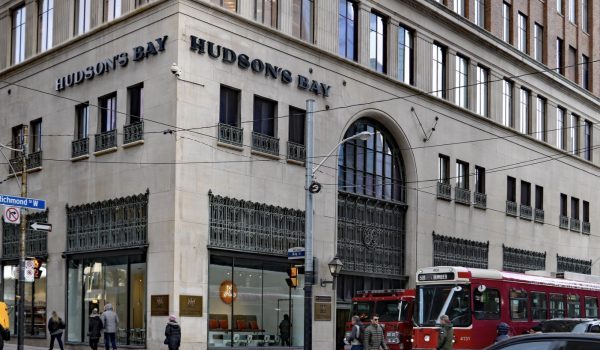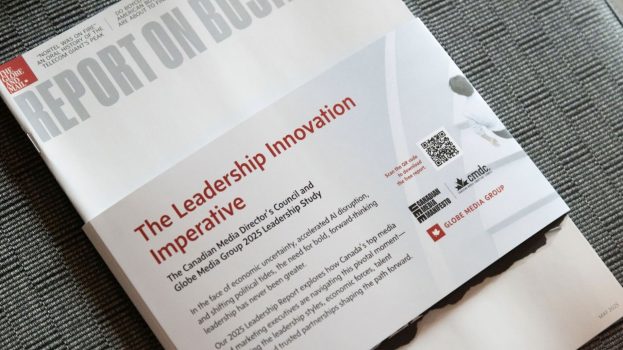In the midst of the one-two punch of 2009’s “Great Recession” and the storm of media innovation that surged up alongside it, print was suddenly looking like a perilous medium: 150-year-old newspapers were closing in the U.S., the iPad was still a closely guarded secret and advertisers were pulling ads in droves thanks to plunging revenues.
In this bleak period, Phillip Crawley, publisher of the Globe and Mail, had good cause to feel nervous. Three years prior, in the still-sunny economic heyday of 2006, the Globe and its printer, Transcontinental, had entered into an 18-year agreement that involved the purchase of cutting-edge new presses that would be the impetus for a radical redesign of the newspaper.
Little did anyone know how much would change in the bitter months of 2009 and early 2010: mobile crystallized into an exciting and viable new medium, the mystical iPad finally became real and social media firmly planted its roots as the medium of choice for young people. It’s a brave new media world out there, but the Globe and Mail is approaching it head-on, sporting the latest cosmetics and draped in Tiffany necklaces. Look out, ladies.
Founded in the mid-1800s, today’s Globe and Mail still has daily news reportage and an ink-on-paper format in common with its 19th century self. But the paper that appears on readers’ doorsteps this month is a much different product than the Globe has ever put forth.
Launched Oct. 1, the “new” Globe has four paper-stock options, all of which can be printed in the same run on a single press. (Although most issues will likely only feature two stocks at a time.) The jewel of the new presses is the high-gloss stock; resembling a newspaper page only in shape, the premium stock looks and feels like a magazine. There is also a slightly thinner, more matte version of the glossy stock – both considered premium on the rate card – as well as bright-white and standard newsprint.
The glossy pages have a transformational effect, taking a plain Jane newspaper ad or layout and turning it into a fancy magazine-quality spread.
“You would want one of those, wouldn’t you?” Crawley asks, grinning and pushing a glossy eggshell-blue page featuring fancy Tiffany necklaces across the table.
“That’s the kind of standard that we want to get in the newspaper, both from an editorial design point of view and an advertising point of view. We want to show them that newspapers are capable of doing things that previously only magazines could do,” he says.
A full-page sample ad for Vichy cosmetics draws another grin from Crawley. The L’Oréal brand is traditionally a magazine advertiser, but the new format opens up more clients for the Globe, Andrew Saunders, VP of ad sales, explains.
“We’re positioning ourselves to be a very strong alternative to both the magazine sector and the broadcast sector in catering to that audience,” he says.
The audience to which Saunders refers is an advertisers’ grail: young professionals with enough income to buy swanky consumer goods. A goal of the flashy new redesign, Saunders says, is to build upon last year’s eight percent increase in the Globe’s female audience.
Catering directly to that crowd will be the new Globe Style section in the Saturday edition. Completely redesigned to resemble a magazine, the new section will drop the more mum-and-dadsy foodie content and focus more on trends and fashion. Picking up where it left off will be the new Globe Weekend section, also in the Saturday paper, featuring a more relaxed magazine-style layout but with the more parental vibe of the weekday Globe Life section. Other editorial and stylistic changes include a new look for the front page and a new feature in the news section on the weekend that will be printed on the semi-gloss stock.
Shiny and happy as the new paper may be, it’s undeniable that both readers and advertisers are increasingly interested in digital content, which brings us to another important point in the evolution of newspapers in the digital age: reach across dayparts.
The idea of time spent is a much different concept to the digital generation than it was to their print-raised counterparts, who typically either read the paper in the morning before work or spent the hour between getting home from work and having dinner poring over municipal politics and local crime stories.
Although popular opinion often runs to the contrary, young people, and the digitally inclined, aren’t spending any less time per se with newspapers than their parents or grandparents did, but are doing so in a completely different way, comments Catherine McKercher, a professor of journalism and communication at Carleton University.
“I think young people are every bit as interested in the world as they always have been,” she says. “They may not do the same kind of newspaper reading that their grandparents used to do…but the young people that I know consume six or seven different media in quite a short period of time. They try to be as well informed as anyone else. It’s interesting.”
The changes at the Globe are intended to address the changes in how people consume news today, from both a readership and advertising standpoint. The glossy, female-targeted lifestyle pages of weekend sections such as Globe Style are meant to extend the life of the print edition into the coffee table realm of magazines and the digital strategy will appease both the BlackBerry-toting exec and media-surfing university student. With advertising sold in packages across it all, the newspaper confronts the “web dimes for print dollars” conundrum facing major media today.
“I think it’s really smart of the Globe to leverage their brand as a whole rather than focusing on just the newspaper portion,” says Laura Maurice, manager, print investments, UM Canada. “It will be interesting to see if advertising dollars start shifting if they are successful in scoring that new audience that other papers have yet to capture.”
Obviously, the Globe isn’t alone in its pursuit of audiences across platforms. The National Post, Canada’s only other national newspaper, has had new life breathed into it with the $1.1 billion buyout of its former parent company, Canwest LP, now known as Postmedia Network. The newspaper has upgraded to a new blog-style website, which the paper’s president Gordon Fisher says has already boosted traffic to NationalPost.com. And although he believes engagement with the website will increase significantly due to the simplified commenting functionality, he says content is what’s driving readers to the site and getting them to stay.
“If you don’t have content that is different and compelling, if you’re just producing a website that is yesterday’s newspaper or simply commodity news and information that can be sourced [anywhere], you’re playing a loser’s game,” he says.
In pursuit of that ideal, the editorial rooms of the National Post and all of the Postmedia papers are being restructured with a “digital first” agenda, Malcolm Kirk, VP, digital media, Postmedia Network, explains. The first step in this still-being-defined evolution of Postmedia’s newspaper portfolio is arming all of its reporters and papers with the ability to break news as soon as it happens on multiple platforms and an increased focus on video content. That includes iPad apps for all the papers, set to debut this fall.
“We’re going to radically transform our news gathering coast to coast to be able to deliver content on any platform a person chooses, and making that content as relevant as possible to that device to make [the news] as rich an experience as we can,” Kirk explains.
This strategy will also include a new and much-intensified focus on local newsgathering, which Kirk hints will include a number of new content-sharing partnerships with local online media and community groups. “The potential for our company to expand in those markets is huge,” he says.
Evolution in the digital landscape is key at this point, Maurice says, adding that from a media agency perspective, digital is really just a list of positives.
“Newspapers are getting better at giving consumers what they want,” she says, when asked what attracts media buyers to spending their clients’ dollars on newspapers’ websites. “I’d say there are only strengths at this point: instantaneous accessibility, critical mass with consumers, ease of use, ability to share with friends, and news feeds that are delivered in real time.”
But with all of this money being poured into Canada’s two national newspapers, it raises the question: do people still want to read them?
The stats in the States are a bit bleak, but readership in Canada has remained steady over the past five years. The 2009 NADBank readership survey shows that 77% of Canadian adults living where a daily newspaper is available reported reading a printed or online edition each week, a result consistent with 2008’s report.
Print remains the most popular medium (noting e-reader editions were not as widely available as they are in 2010) with 73% of adults reporting reading a print edition at least once a week (same as 2008) and 22% accessing an online edition (a 2% increase over 2008). Most people, it seems, read both, with only 4% reporting reading online editions only. There is every indication, however, that the number will grow, especially as e-readers and tablets gain marketshare.
Michael Hollett, publisher, Now Magazine, has no time for disparaging attitudes towards print, especially when it comes to appealing to young people through the medium.
“The publishing industry blows my mind in terms of how self-destructive they are and how they are participating in their own demise,” he says with frustration. Free is key in appealing to the hearts and minds of Millennials, he argues.
“These guys can’t get their heads around it,” he says of media tycoons like News Corp’s Rupert Murdoch, who is famously pursuing pay walls at News Corp papers. “You want young people to read you. You don’t want to have your audience just die, which is what is happening, but people aren’t even paying for stuff that they used to pay for, like music. That’s already been lost. So you think that you’re going to get them to pay for stuff they were already not buying?”
In every interview conducted for this story, the common denominator cited as key to continued media company success is quality and individuality of content. This is not a new concept. But in a world where readers will sift through a handful of media outlets in a matter of minutes, having unique content has arguably never been more important. If your stuff is the same as everyone else’s, why would anyone waste their time?
The Globe’s strategy to be unique in its storytelling will remain a core mandate of the newspaper, Crawley says. And by investing in the new look, he hopes to send a message to the ad community at large that print is still worth investing in – because maintaining the kind of newsroom that can pump out three mediums’ worth of content every day is certainly not cheap.
“It makes a big statement to our entire industry that there are people around who have a strong belief in the long-term vitality of
the newspaper business,” he says.
“In the last couple of years, you have lots of prophets of doom telling the world that newspapers are finished. We’re about to show that newspapers are far from finished, that they actually still have lots of new tricks that people haven’t seen yet.”
UM’s Laura Maurice agrees.
“The Globe redesign comes at a very important time for the print industry,” she says. “Publishers will need to evolve with the changing landscape and be on the forefront of technology. By leveraging their brand as a whole and providing their readers with brand solutions for their needs, they will survive. In what capacity I’m not sure, but it will be exciting to see how it all plays out. I personally love the printed word and can never imagine a day when I can’t curl up with my favourite paper, coffee in hand.”























